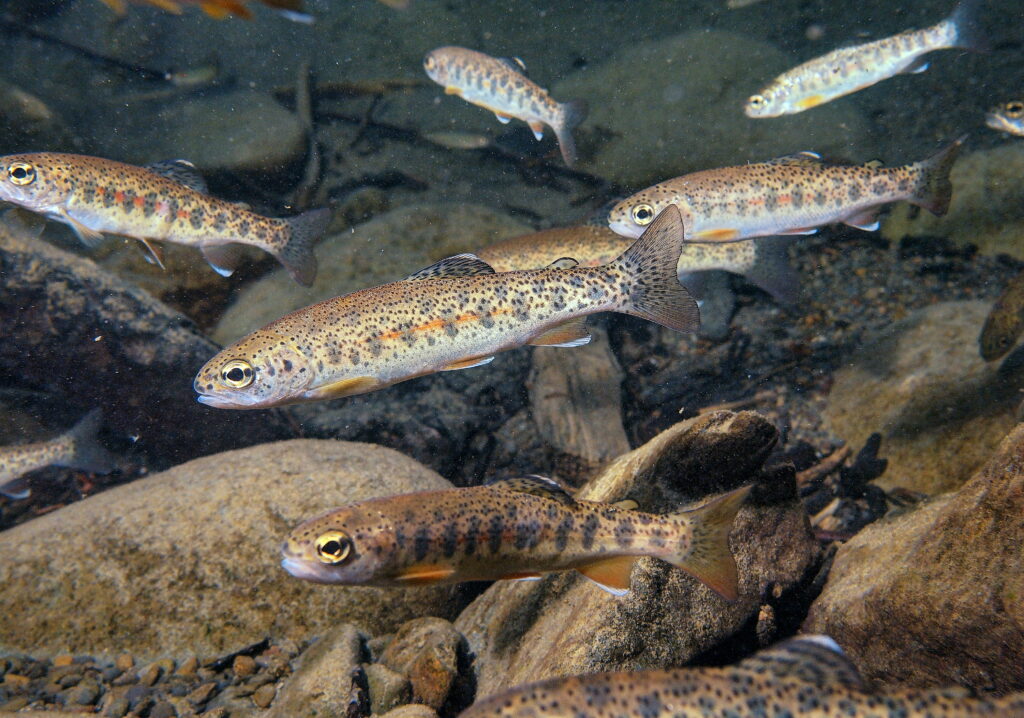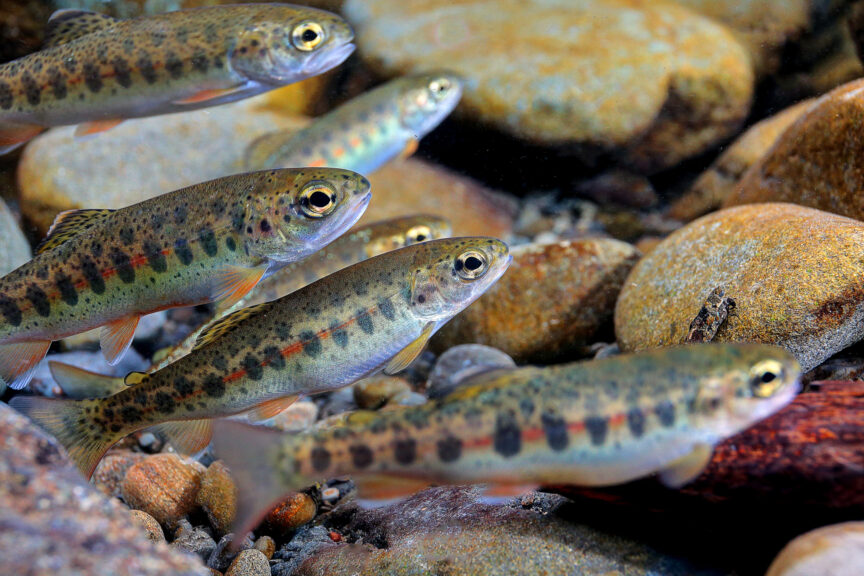Summer is over, but before we put it behind us, it’s worth considering that the summer of 2020 was likely one of the two hottest summers in the northern hemisphere since humans began measuring the temperature of air and water. Hot temperatures directly—and sometimes dramatically—affect steelhead and many other salmonid species.
So our Science Friday review this week of a study of steelhead in California’s Eel River is timely. This study, published in a recent paper by Terrance Wang and several co-authors, investigated whether juvenile steelhead used the mouth of two tributaries – Cedar and Elder Creeks – where they entered into the main-stem Eel, and underscores the challenges that steelhead and rainbow trout face during seasons and extended periods of hot weather.

Image: John McMillan/Trout Unlimited.
Why might juvenile steelhead use the tributary mouths rather than other places in the main-stem Eel? Because the tributaries could be cooler than the main-stem, and thus provide thermal refugia. Thermal refugia are discrete areas of habitat, often at the confluence of tributaries to mainstem rivers, where water temperatures are maintained at levels where fish can hold without expending too much energy.
Such cooler-water habitat areas also may help juveniles grow and survive better, among other benefits.
Wang et al placed thermographs (which measure water temperature) in the tributary plumes and in the adjacent main-stem Eel River and then conducted snorkel surveys to enumerate juvenile steelhead and denote their location within the stream, determining whether the steelhead used the thermal plume or the warmer main-stem Eel, and in what proportion.
Their results should not be surprising.
First, the tributary plumes were substantially cooler than the adjacent main-stem Eel River. For example, main-stem temperatures exceeded 82°F—a very stressful temperature for juvenile steelhead — near one of the creek mouths. In contrast, the coldest locations in the tributary plumes were around 58°F, almost a 30°F difference!
Second, the snorkel surveys indicated juvenile steelhead did rely heavily on the cooler tributary plumes. But their behavior was nuanced. For example, at the Cedar Creek confluence, where maximum temperatures in the main-stem exceeded 82°F, juvenile steelhead moved into the thermal plume on the warmest days and during the warmest times of day. However, most juveniles did not move into the 58F water. Rather, they relied more heavily on the water that was 68-72°F.
In contrast, at Elder Creek, where main-stem temperatures remained below 75°F, they found that juvenile steelhead did not rely heavily on the cooler temperatures where the creek entered the Eel River.
The take-home message is that cooler tributaries may be really important to the growth and survival of juvenile steelhead, especially in places that are already warm and getting substantially warmer due to climate change and other factors. Such habitats maybe critical to the persistence of steelhead in the coming years.
Of course, this study hits home for us at Wild Steelheaders United. We see similar patterns of behavior with adult steelhead, for example, in the main-stem Columbia River. As we have described previously, the main-stem Columbia River becomes very warm during peak summer months and once the river begins to exceed 70°F, a high proportion of adult steelhead move into cooler tributary mouths, like Drano Lake at the mouth of the White Salmon on the Washington side and the mouth of the Deschutes River on the Oregon side (see our previous article on this here).
During warm times, on the Columbia and many other river systems, adult steelhead are essentially trapped as they congregate in the cool water tributaries—and anglers are keenly aware of this tendency. Consequently, as our rivers become increasingly warmer, a debate has developed over whether we should allow angling in those thermal refuges during the hottest parts of the year.
To us, it’s a simple decision. We need to better manage fisheries in thermal refugia, even if it means limiting or curtailing some fishing opportunity. From both a biological and fishery management perspective, there is really no alternative.
Adult steelhead in many rivers fast as they migrate upstream. They rely on their fat stores built up during their ocean life history phase to survive. Warmer water temperatures elevate their metabolism, resulting in fish burning more of their fat stores and potentially harming their ability to migrate upstream, develop their eggs and sperm, and successfully spawn.
That, in fact, is one reason adult steelhead rely on cold water tributary mouths: to conserve their fat stores. And this is why we have worked hard over the past two years to ensure steelhead fisheries are managed to more sustainably account for the challenges that steelhead face during their spawning migration. While Oregon has taken some steps to address the impacts of angling in thermal refugia, Washington has not, which is why we will continue to seek temporary closures of cold-water refuges in the main-stem Columbia on the Washington side.
Ultimately, whether juvenile or adult, steelhead are likely to rely increasingly on thermal refugia, especially in regions and rivers that are already, ahem, in hot water. If you are concerned about the long-term fate of wild steelhead, please join us in supporting those actions we know will help them persist—restoring their critical habitats, removing barriers and dams, and improving management of steelhead fisheries—so future generations can also know the thrill of a wild steelhead at the end of a line.
Interested in reading other Science Friday topics? We got you covered here.


